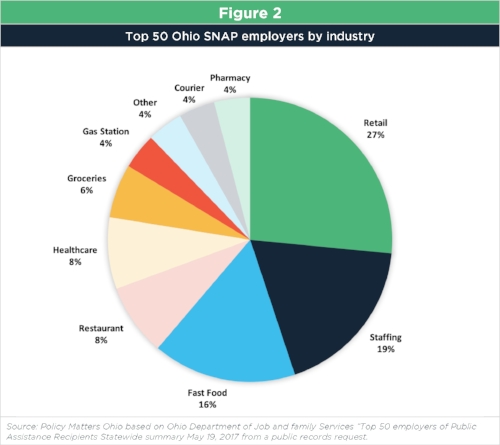Ten percent of Amazon employees in Ohio receive SNAP (Supplemental Nutrition Assistance Program) benefits. This factoid has been ping-ponging across the Internet in the past week or two, since the release of an annual report by Policy Matters Ohio, revealing the top 50 employers of SNAP recipients. It’s data that USDA should collect and reveal annually, so we know which big corporations are subsidizing their costs of doing business with public tax dollars.
This story has legs because it shocks. Amazon can afford to pay its workers better, and certainly Amazon CEO Jeff Bezos can afford to share his wealth. Money magazine has identified him as the richest person on the planet, worth over $100 billion. We also think of Amazon as a tech firm, and tech firms typically pay well. But Amazon is a low-cost retailer, growing its stake in the grocery business. In some ways, it should come as no surprise that its wage practices do not differ all that much from its main competitor, Walmart.
Thirteen and a half percent of Walmart employees in Ohio receive SNAP (13,932 employees and household members divided by the average of 2.02 persons per SNAP household equals 6,897 employees. Walmart reports 51,127 associates in the state). Extrapolated across Walmart’s 1.5 million associates in the U.S., this would indicate that 202,500 Walmart employees (or 409,050 Walmart employees and household members) receive SNAP benefits. At an average benefit level of $125.99 per person, Walmart employee households receive an estimated $618.4 million in SNAP annually.
Walmart employee reliance on SNAP will likely decrease in 2018, as Walmart increases its starting wages to $11/hour. At this salary, an employee in the average two-person SNAP household working 40 hours per week would no longer be eligible for food stamps. Employees working 36.25 hours or less would however qualify be eligible for SNAP; Walmart considers 32 hours to be full-time employment.
Walmart also redeems a lot of SNAP benefits at the till. In 2014, it admitted to cashing in roughly $13 billion of SNAP, or roughly 18% of the total amount spent on the program.
From "SNAP Feeds Ohio" by Policy Matters Ohio. Ohio-only data.
Let’s be clear. SNAP is both individual and corporate welfare. It remains a vital part of the government’s responsibility to fulfill the right to food to the nation’s most vulnerable. As groups such as the Center for Budget and Policy Priorities and Food Research Action Center have accurately pointed out, it has played a key role in diminishing food insecurity.
But when SNAP is used by businesses to avoid having to pay a living wage, when it reduces their cost of doing business, it becomes corporate welfare. Taxpayers subsidize the profits of some of the nation’s largest corporations. It is not just predatory retailers like Walmart and Amazon that feed at the public trough, but as seen in the table below from the Ohio study, much of the food industry. In fact, 30% of the total employees and household members receiving SNAP work at a supermarket or restaurant (excluding big box retailers such as Walmart and Target).
From "SNAP Feeds Ohio" by Policy Matters Ohio. Ohio-only data.
Interestingly, many of these employers who rely on SNAP to bolster their corporate profits have well-established partnerships with anti-hunger groups. In some cases, they (e.g Meijer, Walmart, Kroger) donate excess food to food banks, fund (e.g. Walmart) SNAP advocacy, provide (e.g. Target, Yum Brands – Taco Bell, Pizza Hut and KFC, Arby’s, and Subway) general contributions to the anti-hunger cause, or in the case of Wendy’s resist public pressure to accept the Fair Food Code of Conduct and pay farmworkers an extra penny per pound for winter tomatoes. These contradictions are ones that the mainline anti-hunger groups would prefer to keep out of public view, as they expose the hunger-industrial complex. The answer is not to make sure that SNAP recipients work, as some in Congress suggest. Instead, it is to raise wages and regulate how companies shape part timers' schedules (so workers can piece together multiple part time jobs if desired) so that they can earn a fair living and don't need to receive SNAP in the first place.


